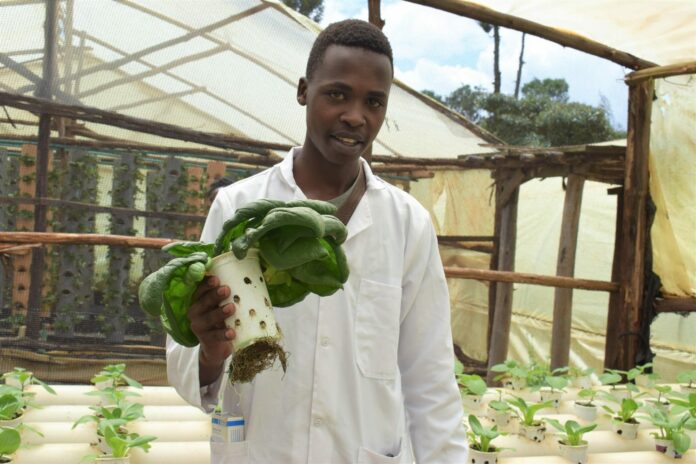The advancing technology has presented new, smart, effortless ways of doing things with young, innovative, and tech-savvy farmers embracing technology to change this traditional sector.
Willard Charawe Maina, a 24-year-old from Murang’a, is one of the youths using technology to bring progressive change into the agricultural space, eliminating the seasonality of fruit and vegetables.
The farmer practices hydroponic farming, a method of growing plants without soil. Instead, he uses mineral nutrient solutions in a water solvent.
“This is smart farming and you can actually farm in a suit and you will still be a farmer. You can practice hydroponics anywhere whether at the rooftop or your balcony. Another advantage is that because you are the one who feeds your plants, it is easy to calculate what you expect to harvest after a known duration,” he says.
Maina says his love for farming started at a young age having been brought up by farming parents.
In his teens, he worked after school and on weekends for local farmers, learning valuable skills such as selecting the right seeds for crops, using the right fertilizer, operating farm machinery, and preparing fields for cultivation.
He opted for hydroponic farming after undergoing training at the Miramar International College. He further enrolled at Chuka University to study Agricultural Education and Extension (AGED).
Today, he owns an eight-by-24-meter ventilated greenhouse in Rongai, Kajiado County, where he grows pepper plants through a media-based trough system.
Ricky Kibet: Why onion farming will earn you more money than other crops
This medium is mainly used to anchor the plants while the nutrient solution is delivered to the plants via sub-irrigation or top irrigation.
“Even though you don’t need soil, the plant’s roots still need something to hold on to. I use BA SF technology to recycle tomato and cabbage waste, which is fed to warmers. The final waste is then mixed with pumice stone,” he told Business Daily.
He notes that the hydroponic systems require less water than traditional soil-based systems adding that he waters his plants once a day depending on the temperature.
“When it is extremely hot, I water twice, in the morning and in the evening. In a day I can use 10,000 liters of water and save up to 700 liters going back into the tank,” he says.
In addition, Hydroponic growing in greenhouses helps the farmer deal with diseases and is also easier to monitor because it is closed.
Maina’s farm currently hosts 1,200 pepper plants, which he says take four months to ripen. He harvests twice weekly, with each plant yielding half a kilo per harvest.
“The first crop can produce 400kg, then it stabilizes at 200kg and then 60kg in the sixth month. At that point you uproot the plant and start again,” he says.
He explains that the red and yellow peppers fetch better prices in the market compared to the green ones.
According to him, the green ones sell for Sh60 per kilogram, while the red and yellow ones go for Sh150 per kilogramme and Sh100 when there is abundance.
“I earn up to Sh300,000 a month from one greenhouse. I harvest for six months straight,” he says.
He has a supplier who takes up to 300 kilos and then distributes it. He sells his produce for between Sh150 and Sh200 per kilo but sometimes gives his buyers a small discount.











